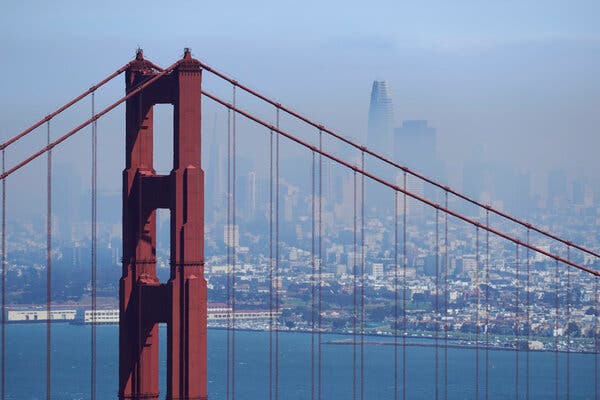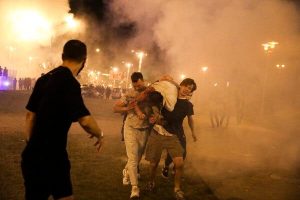Good morning. So far this August, California has been hit hard by wildfires, record high temperatures and power blackouts, all in the midst of a pandemic. One reader asked how residents with respiratory illnesses are faring.
Evan Underwood, who suffers from asthma, migraines and heat sensitivity, has been quarantined inside his home in San Ramon for months. And now, with wildfires raging across Northern California, if the air quality index — which measures pollution levels — goes above 100, going outside for even a few minutes would trigger an asthma attack and migraine that would last an entire day. His plan is to hunker down at home until fire season is over, as long as he doesn’t lose power or is forced to evacuate.
For our series answering readers’ questions about life during the pandemic, Mr. Underwood asked us about how smoke inhalation is affecting people who are high risk for severe Covid-19, like himself, and if they are more vulnerable to significant illness. “If our whole region is bathed in smoke, when so many people still have damaged lungs, the virus is still endemic and people are going back to work, that can’t be good, can it?” he wrote.
As my colleagues have reported, Covid-19 and smoke is a dangerous combination, as both affect the respiratory system, making those exposed to the virus more vulnerable.
Polluted air can also weaken the immune systems of healthy people, making them more susceptible to illnesses like Covid-19, according to experts from the Washington State Department of Health.
And studies have shown that in areas with poor air quality, people are more likely to die if they contract the virus.
[Read the latest updates on the wildfires burning across California.]
“We know that people with asthma or chronic obstructive pulmonary disease are at higher risk for both acquiring Covid-19 and having more severe symptoms if they do become infected,” said Dr. Jeanne A. Noble, an emergency medicine doctor and the director of the Covid-19 response at U.C.S.F. Medical Center’s emergency department. “Adding smoke inhalation into the mix will further increase the vulnerability of everyone to Covid-19, but particularly for those with respiratory problems.”
Dr. Noble said she could see smoke rising above the city as she drove over the San Francisco-Oakland Bay Bridge to work on Wednesday evening. Since March, the emergency department at U.C.S.F. Hospital has been using outdoor tents to properly space patients as they wait to be seen. The fumes will probably make them unusable.
“We’ve been strongly encouraging everyone to take things outdoors. It’s just so much safer. And now we can’t,” she said. “It’s essentially like winter coming early.”
In addition, Dr. Noble said her department would most likely be busier, as there is always an uptick in respiratory cases during power outages from people who rely on electrically powered CPAP machines for breathing or nebulizers for administering medicine. Heat is also a trigger for asthma and emphysema, she said.
For people who have been infected with Covid-19 and have lingering effects, Dr. Michael Daignault, an emergency room doctor at Providence Saint Joseph Medical Center in Burbank, said that since Covid-19 is a multi-systemic inflammatory disease, significant smoke exposure and inhalation, along with an underlying respiratory system disease, could possibly exacerbate symptoms.
“I think this depends on the primary symptoms a patient with Covid-19 had and their underlying medical problems,” he said.
In previous years, people have used N95 masks or respirators to protect themselves against inhaling dangerous particles caused by wildfire smoke.
But Allison Thomas, a reader in Butte County, asked us: “There are no N95 masks available for the general public to use. What are we going to use when the wildfires begin?”
Like everything these days, the pandemic has complicated things. Both the Centers for Disease Control and Prevention and state public health officials are telling people to save N95 masks for workers on the frontline of the pandemic.
The California Department of Public Health states on their website: “Don’t buy N95 respirator masks for personal use. They are part of PPE needed by medical professionals.”
Dr. Noble cautions against the use of N95 masks with exhalation valves. Although they are effective in filtering out particles from smoke, the valves let the wearer’s breath escape the mask, thus posing a risk for spreading Covid-19. If the mask contains an exhalation valve, she said you should wear a surgical mask over it.
If you are feeling the effects of smoke, you should try other means of exposure reduction first.
In its guide for wildfire smoke, the Environmental Protection Agency advised, “Respirators should only be used after first implementing other, more effective methods of exposure reduction, including staying indoors, reducing activity, and using HEPA air cleaners indoors to reduce overall smoke exposure.”
[What to know about buying an air purifier to clear wildfire smoke.]
If you cannot reduce your exposure in other ways, experts say N95 or N100 masks will work to filter out fine particles. But keep in mind that respirators are not approved for infants and small children and may not work on people with beards.
For people with respiratory illnesses, Dr. Daignault said to make sure you have enough medicine in stock and use breathing aids, like albuterol, when needed and seek medical attention if things worsen.
Dr. Noble said, “I think people are going to have to be really vigilant about watching the air quality.” She recommends checking the E.P.A.’s interactive map for updates. “Just as a lot of people have gotten in the habit of tracking Covid-19 numbers to see when their kid’s school might reopen or when their county gets off the watch list, I think people now need to get in the habit of checking the air quality index.”
Have a question about how the pandemic is changing daily life in California? Click here to submit.
Here’s what else we’re following
Read our ongoing coverage of the California wildfires and see where the fires are currently burning. [Latest Updates][Map of Wildfires]
-
A stunning failure of planning, poor record keeping and sheer bad luck left California short of electricity in a heat wave. Power plants with the ability to produce about 15 percent of the electricity on California’s grid were reported as being offline when temperatures surged last Friday. [The New York Times]
-
Hours before Uber and Lyft were due to suspend ride-hailing services throughout California in reaction to a judge’s ruling, an appeals court granted them a temporary reprieve, allowing them to continue operating while the court weighs their appeal. [The New York Times]
-
Gov. Gavin Newsom canceled a planned appearance at the Democratic National Convention on Thursday as fires continue to rage across California, sending in a cellphone video instead. [The Sacramento Bee]
-
Since she first ran for state attorney general in California a decade ago, Kamala Harris has forged close ties with the tech industry. [The New York Times]
-
U.S. Postal Service workers in California reported chaotic conditions at mail facilities, including packages with rotting food, dead animals, and missing or padlocked mail-sorting machines. [Los Angeles Times]
-
Two suspects have been arrested in connection with a hate crime against a group of transgender women in Hollywood this week. [Los Angeles Times]
-
After World War II, thousands of Japanese-Americans returned to the West Coast from internment camps with nowhere to live. Poverty, restrictive housing covenants and racial prejudice led many to seek out housing wherever they could. [The New York Times]
-
The Criterion Collection, a highly prestigious film archive, has largely shut out Black Americans from its collection. Only four films featured in the collection have African-American directors. [The New York Times]
California Today goes live at 6:30 a.m. Pacific time weekdays. Tell us what you want to see: [email protected]. Were you forwarded this email? Sign up for California Today here and read every edition online here.
Jill Cowan grew up in Orange County, went to school at U.C. Berkeley and has reported all over the state, including the Bay Area, Bakersfield and Los Angeles — but she always wants to see more. Follow along here or on Twitter, @jillcowan.
California Today is edited by Julie Bloom, who grew up in Los Angeles and graduated from U.C. Berkeley.



















